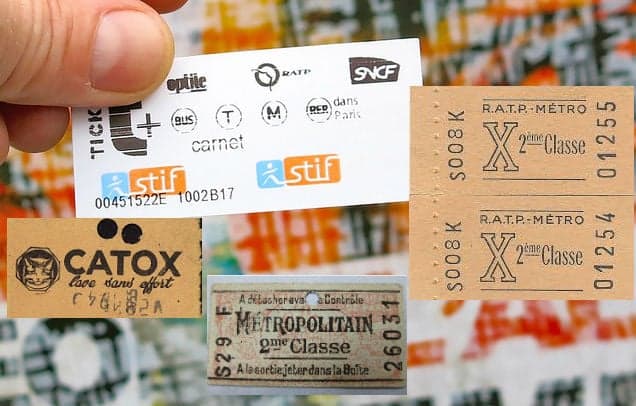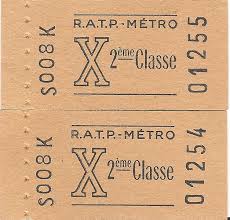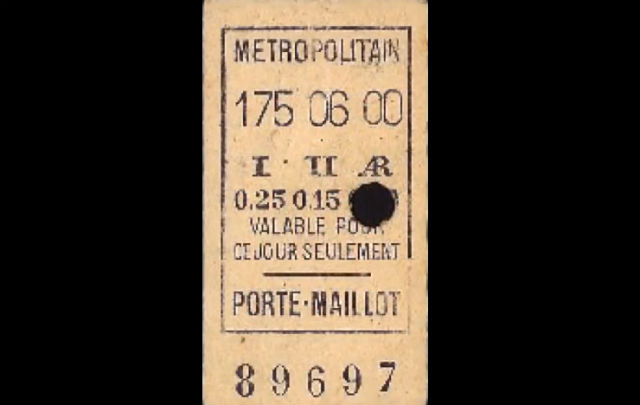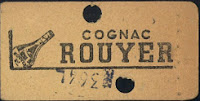The things you need to know about Paris Metro tickets (before they go)

It's the beginning of the end for the traditional lovable/annoying little paper Metro tickets as Paris introduced its new travel card 'Navigo Easy' on Wednesday. But before they're gone for good, here are few things worth knowing about them before they disappear.
It's true that the new card will probably make life easier for those traveling in the Paris region, but that doesn't mean we can't get a bit sentimental about the disappearance of that little ticket that has been with us for so long.
In memory, here are a few things you might not know about the Paris Metro ticket.
Originally, the Metro tickets were printed on paper and then soon after were passed onto printed cardboard with a of 57 X 30 mm format.
The ticket said the name of the company, class, price, date of issue, a letter corresponding to the fare (from 1925) and a serial number.
Following WW1 (1914-1918), the price of a Metro ticket increased for the first time by 5 centimes (second class tickets became 20 centimes and first 30 centimes). More price increases followed shortly afterwards.
READ ALSO:
 In 1925, a new principle was introduced where a letter on the ticket would indicate its tariff, for example Tariff A, and so with each new increase, a new letter was introduced. Tariffs B and C were introduced in 1926, and in 1930, a special reduced Tariff D was introduced for the war wounded. It was only in 1948 that large families could obtain a reduced rate. This letter method lasted until the mid-1970s.
In 1925, a new principle was introduced where a letter on the ticket would indicate its tariff, for example Tariff A, and so with each new increase, a new letter was introduced. Tariffs B and C were introduced in 1926, and in 1930, a special reduced Tariff D was introduced for the war wounded. It was only in 1948 that large families could obtain a reduced rate. This letter method lasted until the mid-1970s.
It's been white since 2007, but the Paris Metro ticket has appeared in many colors of the rainbow including red, yellow, green, orange and purple.
But its shape has always stayed the same, although it had been a vertical ticket in the early years.

Indeed this video below will quickly run you through a visual history of the Paris Metro ticket and how it has changed over the years.
Until 1991, you could buy first-class Métro tickets
 Photo: Naval History & Heritage Command/Flickr
Photo: Naval History & Heritage Command/Flickr
In 1900, when the Metro was first opened, travellers paid 15 cents (of France's previous currency, the franc) for a second-class ticket and 25 cents for first-class.
Some 30,000 tickets were sold on the first day the Metro opened.
These days everyone is in the same class and you'll pay €1.90 for a single journey or €14.90 for a book of ten.
Remember when I was a student in Paris in the 1980s, the Métro still had 1st and 2nd class tickets and carriages — seems like a distant epoch, can't believe I was actually there. https://t.co/HoKuYgRHSI via @TheLocalFrance
— Matthew Fraser (@frasermatthew) July 12, 2018
The tickets once carried advertising on them.
As this great blog on the history of the Paris Metro ticket pointed out, the printing of millions of tickets obviously created an advertising opportunity that some took advantage of including companies selling Cognac and bras.


The tickets have been made into works of art.
 Photo: Luc Grateau
Photo: Luc Grateau
French Painter Luc Grateau painted tiny portraits on Metro tickets, building up a series of more than 2,000 portraits from six years of Metro commuting.
Some have put their origami skills to use by transforming the tickets into the X-wing fighter ships from Star Wars.
The tickets have been given makeovers for specific, important events
The Metro tickets have been redesigned many times over the years, but they've even gotten temporary makeovers for special occasions, such as the Europride LGBT event in 1997.
And in the picture below a Paris Metro worker shows a special edition of subway tickets as part of the celebrations of the Europe Day, 09 May 2006 in Paris.
.jpg)
They have confused and annoyed millions of visitors to Paris over the years.
A quick search of the websites YouTube or Tripadvisor and you will realise just how confusing buying Metro and transport tickets is for foreign visitors.
There are scores of helpful videos trying to explain to visitors why they should buy a book of ten tickets rather than a single one and how the ticket machines work.
Messages left by visitors also reveal their frustration with the ticket system, notably getting mixed up between the tickets they have already used and ones that are still valid. Because the only thing that shows the ticket has been used is a code that gets printed on the back, that is often hard to notice.
Other visitors complain about the small size of the tickets meaning they are easily lost.
Whether you'll miss the tickets or you're happy to see them go, there's no denying that they have been a significant part of Parisian life over the years.
Comments
See Also
It's true that the new card will probably make life easier for those traveling in the Paris region, but that doesn't mean we can't get a bit sentimental about the disappearance of that little ticket that has been with us for so long.
In memory, here are a few things you might not know about the Paris Metro ticket.
Originally, the Metro tickets were printed on paper and then soon after were passed onto printed cardboard with a of 57 X 30 mm format.

It's been white since 2007, but the Paris Metro ticket has appeared in many colors of the rainbow including red, yellow, green, orange and purple.
But its shape has always stayed the same, although it had been a vertical ticket in the early years.

Indeed this video below will quickly run you through a visual history of the Paris Metro ticket and how it has changed over the years.
Until 1991, you could buy first-class Métro tickets
 Photo: Naval History & Heritage Command/Flickr
Photo: Naval History & Heritage Command/Flickr
In 1900, when the Metro was first opened, travellers paid 15 cents (of France's previous currency, the franc) for a second-class ticket and 25 cents for first-class.
Some 30,000 tickets were sold on the first day the Metro opened.
These days everyone is in the same class and you'll pay €1.90 for a single journey or €14.90 for a book of ten.
Remember when I was a student in Paris in the 1980s, the Métro still had 1st and 2nd class tickets and carriages — seems like a distant epoch, can't believe I was actually there. https://t.co/HoKuYgRHSI via @TheLocalFrance
— Matthew Fraser (@frasermatthew) July 12, 2018
The tickets once carried advertising on them.
As this great blog on the history of the Paris Metro ticket pointed out, the printing of millions of tickets obviously created an advertising opportunity that some took advantage of including companies selling Cognac and bras.


The tickets have been made into works of art.
 Photo: Luc Grateau
Photo: Luc Grateau
French Painter Luc Grateau painted tiny portraits on Metro tickets, building up a series of more than 2,000 portraits from six years of Metro commuting.
Some have put their origami skills to use by transforming the tickets into the X-wing fighter ships from Star Wars.
The Metro tickets have been redesigned many times over the years, but they've even gotten temporary makeovers for special occasions, such as the Europride LGBT event in 1997.
And in the picture below a Paris Metro worker shows a special edition of subway tickets as part of the celebrations of the Europe Day, 09 May 2006 in Paris.
.jpg)
They have confused and annoyed millions of visitors to Paris over the years.
A quick search of the websites YouTube or Tripadvisor and you will realise just how confusing buying Metro and transport tickets is for foreign visitors.
There are scores of helpful videos trying to explain to visitors why they should buy a book of ten tickets rather than a single one and how the ticket machines work.
Messages left by visitors also reveal their frustration with the ticket system, notably getting mixed up between the tickets they have already used and ones that are still valid. Because the only thing that shows the ticket has been used is a code that gets printed on the back, that is often hard to notice.
Other visitors complain about the small size of the tickets meaning they are easily lost.
Whether you'll miss the tickets or you're happy to see them go, there's no denying that they have been a significant part of Parisian life over the years.
Join the conversation in our comments section below. Share your own views and experience and if you have a question or suggestion for our journalists then email us at [email protected].
Please keep comments civil, constructive and on topic – and make sure to read our terms of use before getting involved.
Please log in here to leave a comment.